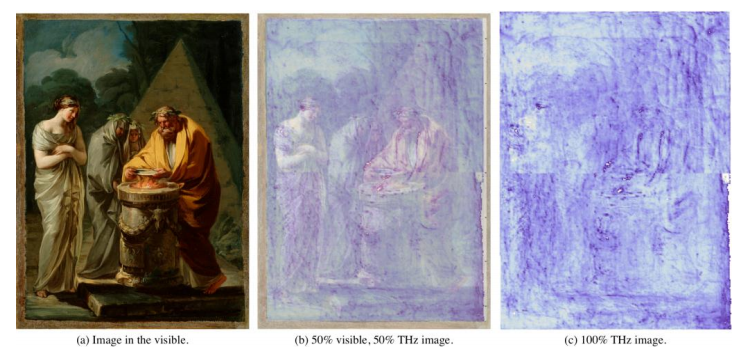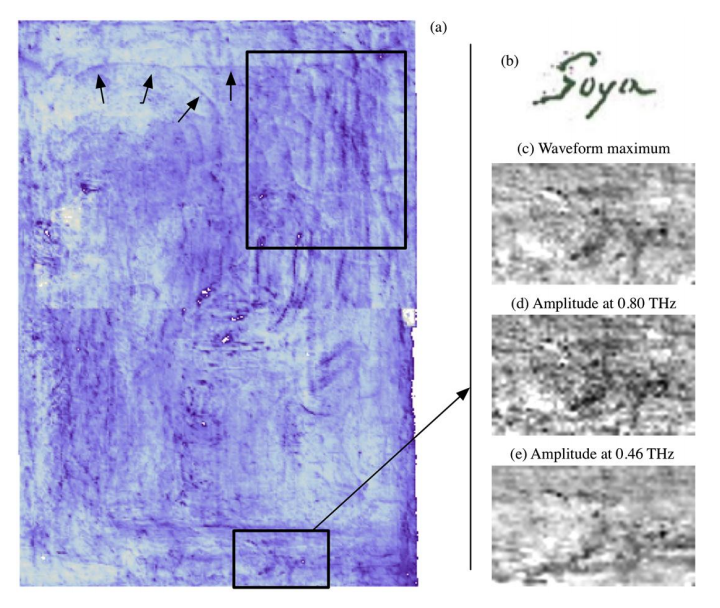Darkened varnish obscures Goya’s signature in a 1771 masterpiece, according to a new analysis using terahertz waves

In1771, the young Spanish painter Francisco Goya travelled to Rome to learn and be inspired by the many great artists there. In that year, he is thought to have painted “The Sacrifice to Vesta” depicting a sacrifice to the goddess of fire. The work is important because it shows how Goya was developing artistically at a formative stage in his career.
There is little dispute that Goya is the author of this work– the artist’s skill and style are clear and various experts have confirmed the attribution. However, the painting lacks a signature, a feature that would leave nothing to debate.
Today, Cristina Seco-Martorell at the University of Barcelona in Spain and a few buddies say they have discovered Goya’s signature hidden behind a layer of varnish in the picture. And the trick they used to make this discovery is an entirely type of analysis using terahertz waves.
Terahertz radiation occupies the part of the electromagnetic spectrum between the infrared and the microwave. Until recently, it had been largely neglected because of the difficulty in producing and detecting terahertz waves.
All that has changed in recent years thanks to a new generation of cameras capable of producing and sensing this type radiation.
Seco-Martorell and buddies imaged the painting by dividing it into 1 mm square pixels. They created their image by recording the terahertz reflection from each pixel and then assembled them into a full image of the painting.
The resulting images are much more revealing than those created using infrared or x-rays. Terahertz waves can be reflected from various layers within a painting giving a three-dimensional picture of how the artwork was put together. At the same time, terahertz waves are selectively absorbed and reflected by different types of pigments and materials and this gives spectroscopic information about the nature of the paints that were used.
The big surprise in this analysis is the discovery of a signature in the bottom right-hand corner of the painting. Seco-Martorell and co say their images clearly reveal the G and the “ya” of Goya’s signature, although the “o” is not visible.

This signature does not show up on an X-ray of the picture that was taken in 2007. Seco-Martorell and pals say this is easily explained. “It is likely that the signature was written using a pencil (basically carbon) and that the painting was covered by a top layer of finishing varnish that turned dark over time, hiding the signature to optical inspection,” they say.
And since the atomic weight of carbon in the signature and in the surrounding canvas and paint is very similar, an x-ray would not have picked up the difference.
The signature clearly removes any remaining doubt about the author of this work. It also establishes terahertz imaging is an important new tool for analysing paintings.
An interesting corollary is that this technique has even greater potential. The spectroscopic capabilities of terahertz imaging ought to allow accurate identification of pigments and other materials used in the painting. For example, in the images above, the areas of greater reflectivity probably indicate pigments with a higher metallic content.
However, identifying the exact chemicals and pigments involved is only possible by comparing the results to a database of known chemical signatures and this does not yet exist for artistic materials such as pigments. So there is work for the future.
In the meantime, it’s not hard to imagine that art historians around the world will want to get their hands on terahertz imaging machines in the hope of identifying other unexpected features in famous paintings.
Ref: http://arxiv.org/abs/1305.3101 : Goya’s Artwork Imaging with Terahertz Waves
No comments:
Post a Comment